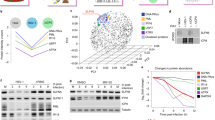Abstract
In light of the scarcity of reports on the interaction between HSV-1 nucleocapsid protein UL25 and its host cell proteins, the purpose of this study is to use yeast two-hybrid screening to search for cellular proteins that can interact with the UL25 protein. C9orf69, a protein of unknown function was identified. The interaction between the two proteins under physiological conditions was also confirmed by biological experiments including co-localization by fluorescence and immunoprecipitation. A preliminary study of the function of C9orf69 showed that it promotes viral proliferation. Further studies showed that C9orf69 did not influence viral multiplication efficiency by transcriptional regulation of viral genes, but indirectly promoted proliferation via interaction with UL25.
Similar content being viewed by others
References
Advani S J, Brandimarti R, Weichselbaum R R, et al. 2000. The disappearance of cyclins A and B and the increase in activity of the G (2)/M-phase cellular kinase cdc2 in herpes simplex virus 1-infected cells require expression of the alpha22/U(S)1.5 and U(L)13 viral genes. J Virol, 74(1): 8–15.
Chien C T, Bartel P L, Sternglanz R, et al. 1991. The two-hybrid system: a method to identify and clone genes for proteins that interact with a protein of interest. Proc Natl Acad Sci USA, 88(21): 9578–9582.
Ehmann G L, McLean T I, Bachenheimer S L. 2000. Herpes simplex virus type 1 infection imposes a G(1)/S block in asynchronously growing cells and prevents G (1) entry in quiescent cells. Virology, 267(2): 335–349.
Goff S P. 2007. Host factors exploited by retroviruses. Nat Rev Microbiol, 5(4): 253–263.
Katze M G, He Y, Jr Gale M. 2002. Viruses and interferon: a fight for supremacy. Nat Rev Immunol, 2(9): 675–687.
Lee J H, Vittone V, Diefenbach E, et al. 2008. Identification of structural protein-protein interactions of herpes simplex virus type 1. Virology, 378(2): 347–354.
Li J F, Liu L D, Ma S H, et al. 2004. HTRP-an immediate-early gene product induced by HSV1 infection in human embryo fibroblasts, is involved in cellular co-repressors. J Biochem, 136(2): 169–176.
Mosmann T. 1983. Rapid colorimetric assay for cellular growth and survival: application to proliferation and cytotoxicity assays. J Immunol Methods, 65(1–2): 55–63.
Navratil V, de Chassey B, Meyniel L, et al. 2009. VirHostNet: a knowledge base for the management and the analysis of proteome-wide virus-host interaction networks. Nucleic Acids Res, 37 (Database issue): D661–668.
Omata T, Kohara M, Kuge S, et al. 1986. Genetic analysis of the attenuation phenotype of poliovirus type 1. J Virol, 58(2): 348–358.
Pasdeloup D, Blondel D, Isidro A L, et al. 2009. Herpesvirus capsid association with the nuclear pore complex and viral DNA release involve the nucleoporin CAN/Nup214 and the capsid protein pUL25. J Virol, 83(13): 6610–6623.
Rickinson A B, Yao Q Y, Wallace L E. 1985. The Epstein-Barr virus as a model of virus-host interactions. Br Med Bull, 41(1): 75–79.
Roizman B, Sears A E. 1996. Herpes simplex viruses and their replication. In: Fields virology (Fields B N, Knipe D M, and Howley P M. ed.), Philadelphia: Lippincott-Raven, p2231–2295.
Song B, Liu J J, Yeh K C, et al. 2000. Herpes simplex virus infection blocks events in the G1 phase of the cell cycle. Virology, 267(2): 326–334.
Song B, Yeh K C, Liu J, et al. 2001. Herpes simplex virus gene products required for viral inhibition of expression of G1-phase functions. Virology, 290(2): 320–328.
Strelow L I, Leib D A. 1995. Role of the virion host shutoff (vhs) of herpes simplex virus type 1 in latency and pathogenesis. J Virol, 69(11): 6779–6786.
Tan S L, Ganji G, Paeper B, et al. 2007. Systems biology and the host response to viral infection. Nat Biotechnol, 25(12): 1383–1389.
Uetz P, Dong Y A, Zeretzke C, et al. 2006. Herpesviral protein networks and their interaction with the human proteome. Science, 311(5758): 239–242.
Wu L-Q, Tang S-Q, Liao Y, et al. 2010. A New Anti-viral Molecule HIRRP Protein Interaction Screening, Validation and Biological Function Analysis. Chin J Cell Biol, 32(6): 862–867. (in Chinese)
Xiao P, Capone J P. 1990. A cellular factor binds to the herpes simplex virus type 1 transactivator Vmw65 and is required for Vmw65-dependent protein-DNA complex assembly with Oct-1. Mol Cell Biol, 10(9): 4974–4977.
Yu X, Liu L, Wu L, et al. 2010. Herpes simplex virus type 1 tegument protein VP22 is capable of modulating the transcription of viral TK and gC genes via interaction with viral ICP0. Biochimie, 92(8): 1024–1030.
Author information
Authors and Affiliations
Corresponding author
Additional information
Foundation item: Scientific Research Fund of the Institute of Pathogen Biology (2007IPB10)
Rights and permissions
About this article
Cite this article
Zhang, Y., Li, Ym., Liu, Ld. et al. Host cell protein C9orf69 promotes viral proliferation via interaction with HSV-1 UL25 protein. Virol. Sin. 26, 171–180 (2011). https://doi.org/10.1007/s12250-011-3179-8
Received:
Accepted:
Published:
Issue Date:
DOI: https://doi.org/10.1007/s12250-011-3179-8




